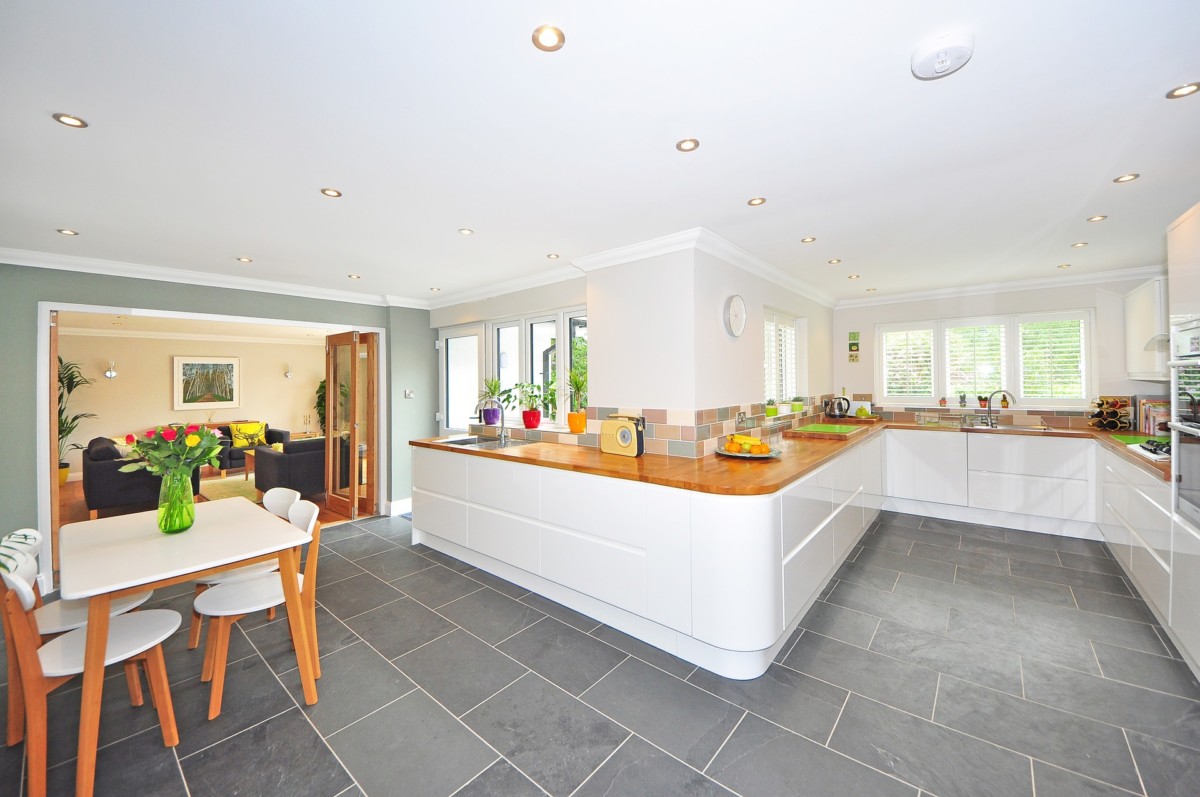What is internal insulation?
Internal insulation is essentially insulation which is applied to the inner face of external walls in a building.
It’s usually bonded or screwed to the walls and usually extends from the very bottom of the ground floor all the way up to the eaves level and then carries on and meets up with the roof insulation.
It’s there to provide a full internal skin of insulation to keep the interior of the building warm.
How does internal insulation work?
It’s applied to the walls. It’s there to prevent heat loss through the walls, but the really important thing about internal insulation is that it provides a barrier between you and the masonry wall beneath.
This is an important point because it’s something that external insulation doesn’t do. External insulation does improve the U values of your wall, but it doesn’t very quickly improve the comfort that you experience inside the building, in the way that internal insulation does.
When you walk into a room, your sense of comfort is defined by a couple of different things. One is the actual physical temperature inside the room, but the other is very important and is actually the feedback that you’re getting from the room itself. This is the amount of infrared radiation which is being emitted by all the surfaces around you and that is felt by your skin.
So even if you apply external insulation to a wall, if you’ve got a very high density masonry wall and you walk close to it, you’ll find that it doesn’t necessarily feel that warm, simply because the wall is absorbing the infrared radiation that’s being emitted by your skin.
Now, if you apply internal insulation to that surface, very quickly you create a surface which warms up much faster and begins to emit infrared radiation back to you. So, when using internal insulation you actually only need relatively small amounts to provide a big improvement in terms of comfort.
What types of insulation are available for the interior?
We typically recommend wood fibre insulation because it’s one that we think is by far the best material to use, but there are lots of different materials on the market.
There are calcium silicate boards, clay boards, cork boards, hemp lime mixes, or insulating plasters. Then there’s lots of other synthetic materials, such as polystyrene or isocyanurate boards.
There’s a whole range of different products that are available for internal insulation.
What type of walls can internal insulation be fitted to?
It’s designed predominantly for solid walls, so it would generally be for solid, cavity brick or block walls (all types of man-made masonry). You can also apply it to the interior of solid natural stone walls.
It can also be applied to timber frames but how much insulation you can use, does depend on the construction of the timber frame because the way that the membranes are installed in timber frame dictates where the insulation can go. So it’s a bit more tricky in timber frames.
What insulations are best for old houses or Listed buildings?
As we’ve worked on old houses and Listed buildings for 23 years, we have generally found that wood fibre is by far the safest material. It’s not the only material though.
There are lots of other materials that can be used, but in terms of safety and risk, wood fibre presents the best possible solution. That is mainly because it’s extremely capable of managing moisture, at moving moisture and it generally keeps the wall below dry. It also very importantly keeps any timbers that are bedded in the wall itself very dry too.
That is one of the most important points about internal insulation because applying insulation to the interior of a building massively changes the way that the walls work. It’s very important that you use an insulation material that can manage moisture and isn’t going to cause either an accumulation of moisture in general, or around specific areas, particularly when you’ve got historic timber or simple floor joists or beams running into the wall which are very sensitive to moisture. If you use the wrong insulation, you can actually cause an accumulation of moisture in those timbers and then eventually that leads to rot.
We have two different types of wood fibre products. We have the UdiIN2CM board which is a purely adhesively fixed board. It uses a lime plaster adhesive to bond it to the wall, which is brilliant for loose friable substrates and very soft historic substrates like soft stone or friable plasters or even materials like cob.
Then we have thicker boards which would be products like the Pavatherm Profil. They come in a 40 mm and a 60 mm board, and these wet processed boards provide high levels of insulation and also a very high capacity for moisture storage and moisture movement, so the boards can dry out very quickly as soon as the weather warms up, and they also disperse moisture within the wall and keep the wall beneath dry – which is obviously a very important factor for historic buildings where you have materials which are very sensitive to moisture.
Can I internally insulate a filled cavity wall?
No, you can’t. Filling a cavity wall allows moisture to move from the outer leaf to the inner leaf and if you insulate the interior as well, you are preventing any heat that is going into the wall from helping to dry that out, and so applying insulation to the inside of that is quite likely to give you conditions where mould grows and damage is done to the internal insulation boards too.
Will internal wall insulation cause condensation problems?
That’s quite an important question but generally we’ve found that when using thinner wood fibre boards there is no problem. Using synthetic boards and systems where you incorporate a cavity between the insulation board and the wall, you may well get condensation and mould problems. It is important to consider, when you’re looking at the materials you’re going to use for internal insulation, that you consider how vapour permeable they are and how able they are to manage moisture and distribute moisture, not just the insulation performance of the material.
Can internal wall insulation be put in place or stuck with dot and dab?
Again, the answer is absolutely not. The dot and dab process creates a void behind the boards. You have the dabs of plaster applied to the back face of the board and when that’s pressed against the wall, you end up creating a little cavity behind those insulation boards which allows air movement, which in turn allows condensation to form and potentially mould growth. That can then lead to problems with mould getting into your inner environment.
What is the least amount of insulation I need to apply to my walls and what U value should I achieve?
The more insulation you apply to your walls, the thicker it becomes and the less floor space you will have or the more floor space you will lose, and so obviously you should be wary about how much insulation is applied to the inner face of the wall.
Our thinnest board is 23 mm thick and that is the thinnest board that we have available that will give you a big boost in comfort and a reasonably good improvement in heat loss.
When Building Control are involved, they tend to specify that the minimum U-value should be 0.7 W/m2K for historic buildings, but that can be a lot lower depending on what other works are being done to the building. It’s really important that when you’re thinking of installing internal insulation that you do talk to Building Control and see what they would like you to target in terms of U values. We can then tell you how much insulation you need to apply to the walls.
Can I internally insulate part of my house, but not all of it?
Yes, you can, but the more you insulate the interior, the more the section that is not insulated can become problematic. That’s essentially because as you insulate the inside of the building, raising the internal temperature, you begin to raise the amount of moisture that is in the air and so you increase the risk of getting condensation on cold parts of the building – which are, in other words, the areas that you’re not insulating. So yes, you can do it in the short term, but in the longer term it is worth doing the whole of the interior so that you don’t have issues with condensation and mould growth in those areas which haven’t been insulated.
Does internal wall insulation need a vapour control layer and are there any other considerations that I should think of when insulating?
That’s a really interesting question because certainly at the thinner layers of insulation – so when we’re supplying 40 mm, 23 mm, anything up to 60 mm really – we generally aren’t too concerned with vapour control.
From 60 mm onwards, which will give you U values from about 0.5 W/m2K downwards, it is really important to start thinking about vapour control, but it’s also very important to start thinking about moisture ingress from the outside.
So yes, you do need to think about a vapour control layer and typically we use a product called UdiMultigrund, which is a vapour regulating plaster or a vapour controlling plaster. That reduces the amount of interstitial condensation that’s going to form in the insulation during the winter. You also need to think about preventing moisture ingress from the outside and that’s particularly important when you’re working on walls which are made of porous brick or porous stone. This is particularly important when using sandstone, as you need to consider how much rain is going to be absorbed in the outer surface and use materials such as facade impregnating creams to reduce the amount of moisture ingress. This prevents problems with a build up of moisture in the walls and problems with frost damage, timber decay and insulation decay in the wall.
Finally, does internal wall insulation help with soundproofing?
Yes it does but possibly to a lesser extent than you might think. Normally if you’re insulating a masonry wall, the masonry itself will be the best acoustic absorber. Adding internal insulation will tend to help more if the masonry itself is quite air permeable, so the poorer the pointing in it is, the more benefit you’re going to get from adding internal insulation, But generally, it won’t make that much difference simply because masonry is a better sound insulator than insulation.
However, when you’re working on party walls particularly – and this tends to be where we get most queries about sound insulation – the best way to insulate party walls is actually to use a thin timber frame, to use resilient bars and to mount our clay boards on those bars.
That works two-fold. You’ve got the resilient bars providing an air cushion between the clay boards and the structure underneath. You can use wood fibre wool in the timber frame beneath to absorb air borne sound and then the clay board mounted on the surface again absorbs a lot of air borne sound and provides really high levels of sound insulation.
That concludes this week’s show. If you have any further questions about this topic or sustainable building materials, please feel free to email at Ch***@************co.uk or alternatively give me a ring on 01392 861763.

